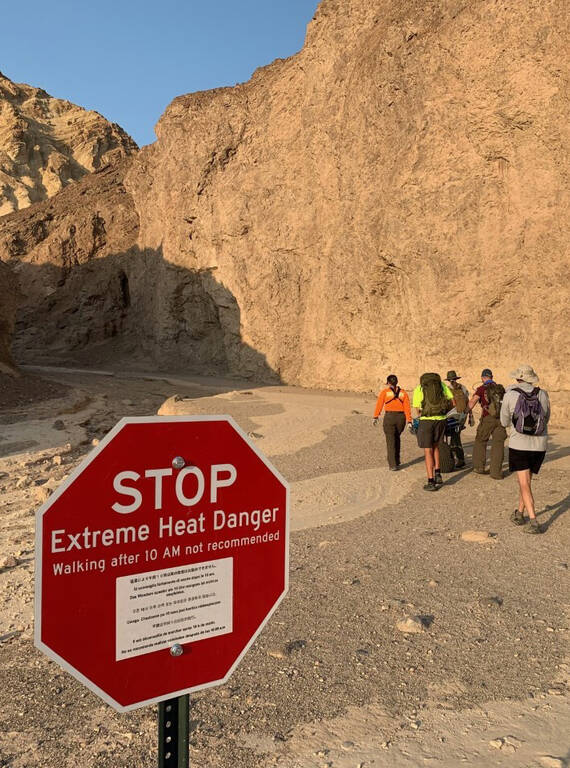A year after its passage, 2022’s Inflation Reduction Act remains a historic climate investment in national parks. It can’t be the only one.
Thanks to NPCA members and supporters who wrote thousands of messages to their elected officials, the historic Inflation Reduction Act passed a year ago this week, giving us all cause for celebration.
The act also gives Americans hope for the future and the promise of climate-conscious projects that safeguard our parks from extreme weather, natural disasters and the inevitable long-term challenges of climate change.
How does the Inflation Reduction Act help national parks and the communities that rely on them?
Passed in August 2022, the Inflation Reduction Act set aside $700 million for infrastructure projects to help parks face the new climate reality. While last summer brought floods to Yellowstone, historic drought at Lake Mead and fires that burned Yosemite’s beloved sequoias, this summer has demonstrated that climate change continues to plague the world in new and unpredictable ways.

A heat warning sign on Golden Canyon trail in Death Valley National Park.
NPS / K. RossThe Park Service works to keep national parks safe and enjoyable, despite operating on a limited budget and with dwindling staff numbers. Last August, the country moved forward with a huge part of the solution: The Inflation Reduction Act remains the largest investment our country has made in national parks to meet the challenges of climate change. And that means investments in the places we love and cherish, as well as the communities who rely on them for solace in nature and economic prosperity.
This funding will contribute both to ecosystem restoration and conservation projects, as well as staffing across national parks.
How will the federal government allocate this funding?
On Aug. 8 of this year, the federal government announced the first round of IRA-funded projects, which span from Glacier Bay National Park in Alaska to Biscayne National Park in Florida. In addition to infrastructure, the Inflation Reduction Act allocates funding for new positions for national park employees. The distribution of $44 million for park projects includes:
$1 million to restore the shortgrass prairie sagebrush and Mesquite Bosque ecosystems in Western parks, and $750, 000 to restore federally threatened whitebark pine, also across Western parks, including Grand Teton National Park.
$203,000 to implement coral reef stewardship in six parks in Florida and the U.S. Virgin Islands, including Biscayne National Park, where climate change has set record-breaking water temperatures, bleaching coral reefs and killing marine life.
$8 million to restore aquatic ecosystems to prepare for climate impacts on wildlife, including at Glacier Bay National Park and Preserve.
$750,000 to assess and treat cultural resources threatened by climate change in Tallgrass Prairie National Preserve.
Over $2 million for mining cleanup, including $120,000 to monitor and rehabilitate former mines in Big South Fork National River and Recreation Area and $300,000 for the National Park Service to develop a database to document abandoned mines on park lands.
How do these projects help national parks?
National parks, public lands and waterways are among our country’s best defenses against climate disasters. The Inflation Reduction Act sets aside much-needed funding for parks to build green infrastructure such as those listed above, which help parks withstand the extreme heat and drier, hotter conditions in the West and the wetter conditions in the East.
Nature-based solutions such as wetlands and other green infrastructure filter pollutants and provide flood and storm protection. Protected freshwater and marine areas better adapt to warming temperatures and rising waters. And, connected and expanded landscapes allow wildlife to safely migrate between national parks and adjacent lands to ensure populations can adapt and survive.
We must equip park personnel with the necessary funds not only to recover from climate disasters, but to look forward to projects and initiatives that support the parks we know and love so they can thrive for future generations.
The good news is that the public is aware of climate change and how we tackle the issue: A January 2022 national poll by NPCA found that a strong bipartisan majority of Americans see parks as part of the solution to address climate change. And 83% of Americans, regardless of political affiliation, would be likely to support representatives in Congress who act to reduce the impact of climate change on national parks. A majority of Americans support the Inflation Reduction Act because it better equips the National Park Service to handle the effects of climate change on our national parks and cultural resources.
Why do parks need funding like the Inflation Reduction Act?
Right now, national parks face a challenge unlike any they have faced before. Climate change continues to surprise scientists in its severity and speed. With the Earth warming a predicted 1.5 degrees Celsius over the next 20 years, we cannot predict how severe or frequent climate disasters will be for national parks. In fact, just in the past decade, we have experienced unusual weather events that mark an unprecedented future for our most treasured lands.
In a December 2022 poll, NPCA found that a total of 73% of Americans believe national parks need better infrastructure that protects against such impacts of climate change. The IRA funding for parks is an answer to that call.
How do Americans feel about the Inflation Reduction Act?
That same December 2022 poll by NPCA found that a total of 79% of Americans support funding the National Park Service to rebuild green infrastructure — in other words, restoring wildlife habitat, improving controls for pollution runoff and making other changes that strengthen parks against climate impacts.
Three in four Americans believe that climate change has already had a negative impact on national parks. About just as many Americans believe national parks need better infrastructure that protects against the impacts of climate change.
How has NPCA supported this bill?
Alongside millions of concerned Americans, NPCA has long pressed Congress for climate action. We’ve sent letters and policy priorities and spent hours meeting with House and Senate offices. This historic legislation is a necessary and essential step forward to meet the needs of people everywhere who have told their representatives that we need to act on the climate crisis now.
Ultimately, though, the IRA is a first step among many we must take as a country to help our national parks survive for future generations. Without more supportive funding directed toward climate adaptation, parks will continue to suffer immensely, harming communities and the visitor experience.
Stay On Top of News
Our email newsletter shares the latest on parks.
About the authors
-
 Daniel Hart Director of Clean Energy and Climate Resiliency Policy
Daniel Hart Director of Clean Energy and Climate Resiliency PolicyAs the Director of Clean Energy and Climate Resiliency Policy for the Government Affairs team, Daniel advocates for a clean energy transition on public lands and waters as well as climate policies to help protect and preserve parks.
-
 Lam Ho Senior Climate Communications Manager
Lam Ho Senior Climate Communications ManagerServing as NPCA’s Senior Climate Communications Manager, Lam calls attention to the effects of climate change on public lands with an emphasis on air quality and environmental justice.
-
General
-
Issues


